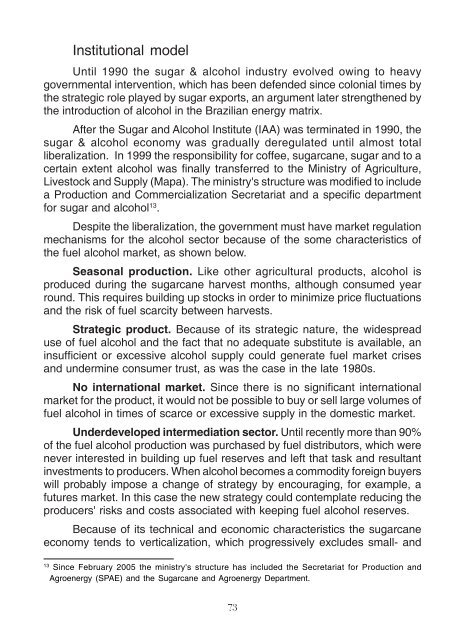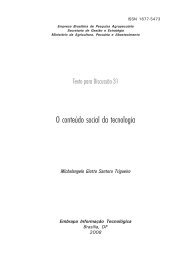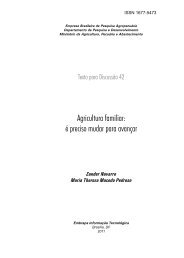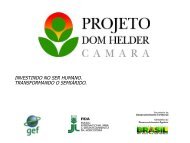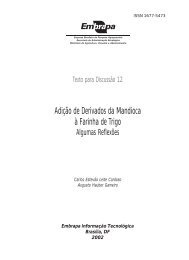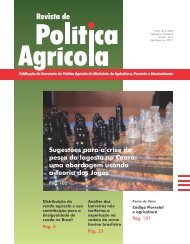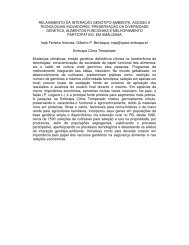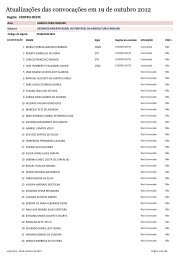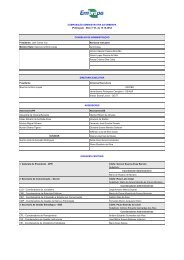Ministry of Agriculture, Livestock and Food Supply - Embrapa
Ministry of Agriculture, Livestock and Food Supply - Embrapa
Ministry of Agriculture, Livestock and Food Supply - Embrapa
Create successful ePaper yourself
Turn your PDF publications into a flip-book with our unique Google optimized e-Paper software.
Institutional model<br />
Until 1990 the sugar & alcohol industry evolved owing to heavy<br />
governmental intervention, which has been defended since colonial times by<br />
the strategic role played by sugar exports, an argument later strengthened by<br />
the introduction <strong>of</strong> alcohol in the Brazilian energy matrix.<br />
After the Sugar <strong>and</strong> Alcohol Institute (IAA) was terminated in 1990, the<br />
sugar & alcohol economy was gradually deregulated until almost total<br />
liberalization. In 1999 the responsibility for c<strong>of</strong>fee, sugarcane, sugar <strong>and</strong> to a<br />
certain extent alcohol was finally transferred to the <strong>Ministry</strong> <strong>of</strong> <strong>Agriculture</strong>,<br />
<strong>Livestock</strong> <strong>and</strong> <strong>Supply</strong> (Mapa). The ministry's structure was modified to include<br />
a Production <strong>and</strong> Commercialization Secretariat <strong>and</strong> a specific department<br />
for sugar <strong>and</strong> alcohol13 .<br />
Despite the liberalization, the government must have market regulation<br />
mechanisms for the alcohol sector because <strong>of</strong> the some characteristics <strong>of</strong><br />
the fuel alcohol market, as shown below.<br />
Seasonal production. Like other agricultural products, alcohol is<br />
produced during the sugarcane harvest months, although consumed year<br />
round. This requires building up stocks in order to minimize price fluctuations<br />
<strong>and</strong> the risk <strong>of</strong> fuel scarcity between harvests.<br />
Strategic product. Because <strong>of</strong> its strategic nature, the widespread<br />
use <strong>of</strong> fuel alcohol <strong>and</strong> the fact that no adequate substitute is available, an<br />
insufficient or excessive alcohol supply could generate fuel market crises<br />
<strong>and</strong> undermine consumer trust, as was the case in the late 1980s.<br />
No international market. Since there is no significant international<br />
market for the product, it would not be possible to buy or sell large volumes <strong>of</strong><br />
fuel alcohol in times <strong>of</strong> scarce or excessive supply in the domestic market.<br />
Underdeveloped intermediation sector. Until recently more than 90%<br />
<strong>of</strong> the fuel alcohol production was purchased by fuel distributors, which were<br />
never interested in building up fuel reserves <strong>and</strong> left that task <strong>and</strong> resultant<br />
investments to producers. When alcohol becomes a commodity foreign buyers<br />
will probably impose a change <strong>of</strong> strategy by encouraging, for example, a<br />
futures market. In this case the new strategy could contemplate reducing the<br />
producers' risks <strong>and</strong> costs associated with keeping fuel alcohol reserves.<br />
Because <strong>of</strong> its technical <strong>and</strong> economic characteristics the sugarcane<br />
economy tends to verticalization, which progressively excludes small- <strong>and</strong><br />
13 Since February 2005 the ministry's structure has included the Secretariat for Production <strong>and</strong><br />
Agroenergy (SPAE) <strong>and</strong> the Sugarcane <strong>and</strong> Agroenergy Department.<br />
73


